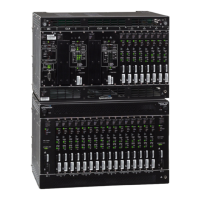34 097-55501-01 Issue 6 – June 2003
1
TimeHub 5500 System Guide
False Reporting of Output Port Alarms
When connecting an output signal from TimeHub to a single-ended device
(such as an oscilloscope or other type of test equipment), it is possible that
false port alarms may be reported. This can occur when the connection from
the TimeHub differential outputs (Tip and Ring) to the single-ended device
(which has signal and ground) is made improperly. Often this connection is
made by connecting Tip or Ring to ground (shell of connector on test
equipment) and the other signal (the one that was not connected to ground)
to the signal input on the test equipment. Connecting in this way creates a
path for ground-related noise coming from the test equipment ground (e.g.,
60 Hz from utility, ground-loop effects, etc.) to be injected back into the
alarm-sensing circuit in TimeHub (via the Tip or Ring that was connected to
equipment ground). The result can be that the sensing circuit sees its
detection thresholds exceeded (due to the induced noise) and reports a false
port alarm. This same situation can also temporarily occur when connecting
or disconnecting differentially with test equipment if the connection plug has
the possibility of momentarily allowing either of the differential signals to
contact the equipment ground. In this case a way to avoid the possible false
port alarm is to enable the output only after the physical connection to the
test equipment is completed.
Other than the possible alarm reporting, a measurement made with such a
connection remains as valid as it would otherwise have been. While such a
connection cannot be used in any case for evaluation of output signal
characteristics such as mask compliance or amplitude levels (because the
connection scheme is inherently improper due to direct connection of a
signal line ground), it is an acceptable method for basic signal checking such
as signal presence. Even though TimeHub may report a port alarm, the
TimeHub output signal will still be generated. Also, this connection method
will not damage the TimeHub output circuits.
So, while it is acceptable to directly connect as described previously (for
limited types of tests), the recommended method for connecting from
differential to single-ended is via a transformer, as is expected when
connection is made to the equipment that will ultimately be timed by the
output. With this type of connection, reporting of false port alarms should
not occur.
Clearing of False Port Alarms
A false port alarm will normally self-clear when the reason for its occurrence
is removed. For example, if TimeHub Ring output connected to test
equipment ground is the reason for a false port alarm, removing that
connection will typically clear the alarm within a few seconds. If the alarm
does not self-clear, the CLRPTALL keyword can be used to request an
attempt to clear the alarm (see TimeHub 5500 TL1 reference manual,
keyword CLRPTALL).

